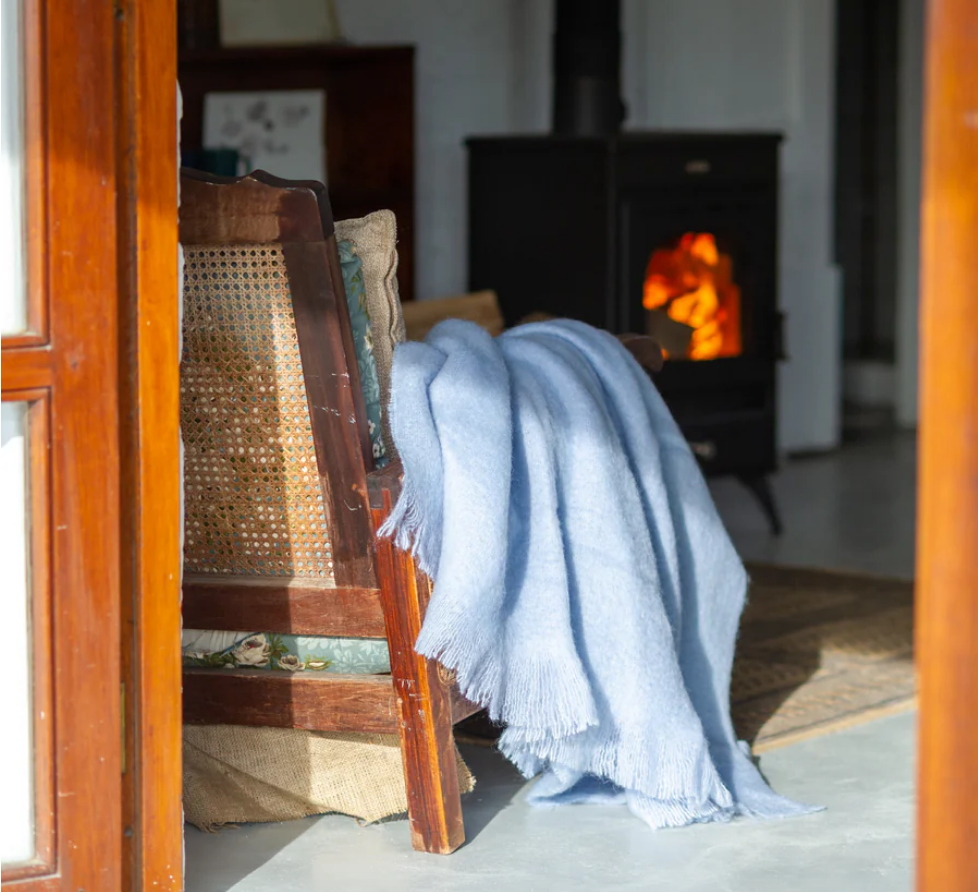
What is Mohair anyway?
Share
To celebrate that we will be stocking the luxurious CAPE MOHAIR Mohair and wool blankets, we thought we'd share a bit of info with you on thsi absolutely stunning and beautiful product!
Mohair, often referred to as the "diamond fiber" for its sheen and luster, is a luxurious textile material derived from the hair of the Angora goat. Unlike the Angora rabbit, which produces Angora wool, the Angora goat is the sole source of mohair. Known for its silky texture, resilience, and insulating properties, mohair has been a prized fiber for centuries, used in everything from high-fashion garments to durable upholstery fabrics.
The History of Mohair
The history of mohair is deeply intertwined with the history of textile production itself.
Origins and Early Use: Mohair is believed to have originated in the Himalayan region, but it was in Turkey where the fiber gained significant prominence. The name "mohair" is derived from the Arabic word "mukhayyar," meaning "choice" or "select." By the 16th century, the Angora goat and its luxurious fiber were highly valued commodities in Turkey, particularly in the province of Angora (modern-day Ankara).
Introduction to Europe: In the 16th century, mohair found its way to Europe. Initially, the export of raw mohair was controlled by the Ottoman Empire, ensuring the fiber's exclusivity. Eventually, European weavers and textile manufacturers began to appreciate and adopt mohair, leading to increased demand and trade.
Expansion to the New World: The 19th century saw the introduction of Angora goats to South Africa and the United States, particularly in Texas. These regions, with their favorable climates and grazing conditions, became major centers for mohair production. Today, South Africa and the United States are among the leading producers of mohair globally.
Production of Mohair Yarn
Creating mohair yarn is a meticulous process that involves several stages, from shearing the goats to spinning the fiber into yarn suitable for various applications, including blankets.
Shearing: Angora goats are typically sheared twice a year, in the spring and fall. Each goat can produce between 5 to 8 kilograms of mohair annually. The fleece is collected and sorted by quality, with the finest and longest fibers reserved for high-end textiles.
Cleaning: The raw mohair fleece undergoes a thorough cleaning process to remove dirt, grease, and other impurities. This is usually done through a series of washes and rinses, ensuring the fiber is as clean and pure as possible.
Carding: Once cleaned, the mohair fibers are carded. Carding involves disentangling and aligning the fibers, creating a continuous web or sliver. This process can be done manually or using mechanical carding machines.
Spinning: The carded mohair fibers are then spun into yarn. Spinning can be done using traditional spinning wheels or modern spinning machines. The process twists the fibers together, creating a strong, cohesive thread. Depending on the desired yarn thickness and texture, mohair can be spun into fine, medium, or bulky yarns.
Dyeing: Although natural mohair ranges from white to various shades of gray and brown, it can be dyed into a wide array of colors. Dyeing is typically done after spinning, ensuring uniform color distribution throughout the yarn.
Finishing: After dyeing, the mohair yarn is finished to enhance its softness and sheen. This may involve washing, steaming, and brushing the yarn. The final product is a luxurious, resilient yarn ready for knitting or weaving.

Mohair Yarn for Blankets
Mohair yarn is particularly valued for making blankets due to its unique properties:
Softness and Warmth: Mohair fibers are incredibly soft and warm, making them ideal for cozy blankets. The fiber's natural luster and sheen also add an element of luxury to the finished product.
Durability: Mohair is known for its strength and durability. Mohair blankets are not only soft and warm but also resistant to wear and tear, ensuring they can be enjoyed for many years.
Insulating Properties: Mohair fibers have excellent insulating properties. They can trap air and retain heat, providing exceptional warmth even in cold conditions.
Moisture-Wicking: Mohair naturally wicks moisture away from the body, keeping the user dry and comfortable. This property is especially beneficial in blankets, ensuring a comfortable sleep environment.
Mohair is a remarkable fiber with a rich history and a complex production process. From the ancient hills of Turkey to modern farms in South Africa and the United States, mohair continues to be a symbol of luxury and quality in the textile world. Whether spun into fine yarn for elegant garments or thick yarn for cozy blankets, mohair's unique properties make it a beloved choice for discerning consumers worldwide.
Find the most beautiful Cape Mohair blankets right here on our webshop!
